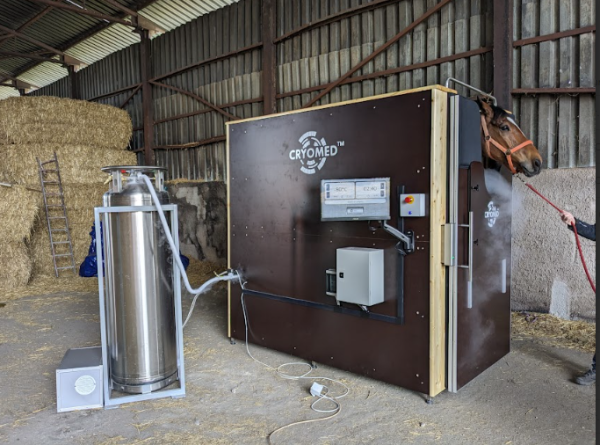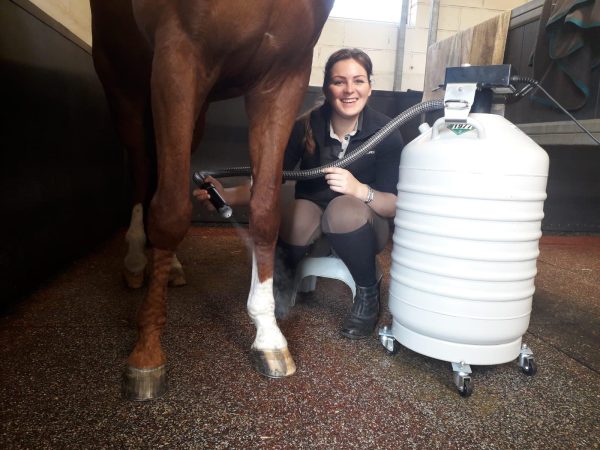Equine cryotherapy, including the use of an equine cryotherapy machine, has become an integral part of horse wellness and recovery routines, offering a non-invasive means of enhancing performance and maintaining overall health. By utilizing cold temperatures, this technique aids horses in achieving optimal physical conditions, making it a popular choice among horse owners, equine vet clinics, horse training facilities and rehabs.
Understanding Equine Cryotherapy
At its core, equine cryotherapy involves applying cold treatments locally or for the whole body. While the techniques and the temperature levels used in cold therapy differ, the purpose of cold applications remains the same: to promote well-being and readiness by alleviating minor discomforts and enhancing the horse’s natural recovery processes.

Techniques of Equine Cryotherapy
There are several cryotherapy methods used for horses, each suited to different conditions:
1. Cold Hosing.
- Description. Cold water is continuously run over the affected area.
- Common use. Often used for leg injuries or inflammations such as endonitis or joint swelling.
- Advantages. Easy to apply, cost-effective, and ideal for minor injuries.
2. Ice Baths or Immersion.
- Description. The horse’s legs or body are submerged in water containing ice.
- Common use. Effective for reducing acute inflammation in the lower limbs after strenuous exercise or injuries.
- Advantages. Provides deep cooling and is more intense than cold hosing.
- Challenges. Requires specialized equipment (large tubs) and careful monitoring to avoid cold burns.
3. Ice or Gel Packs.
- Description. Ice packs or frozen gel wraps are applied to specific areas.
- Common use. Targeted therapy for localized injuries like joint inflammation or muscle strains.
- Advantages. Portable and can be applied with compression for enhanced benefits.
4. Cryotherapy Boots.
- Description. Specialized boots with built-in cold packs, often combined with compression, are wrapped around the horse’s legs.
- Common use. Used for lower limb injuries or post-exercise recovery in performance horses.
- Advantages. Provide uniform cooling and compression for effective treatment.
5. Whole-Body Equine Cryotherapy.
- Description. Special walk-in open-top cryosaunas with a working temperature down to -120°C. Unlike the above methods, the whole horse’s body, except for the head, is exposed to below-freezing temperatures.
- Common use. Ideal for treating inflammation in tendons, ligaments, and joints, post-injury and post-exercise recovery, and performance boost.
- Advantages. Has a systemic effect rather than local, triggers natural healing mechanisms, and affects all foci at a time. Fast, convenient, and effective.
6. Local Equine Cryotherapy
- Description: Specially designed cryogenic blowers that use liquid nitrogen to generate a stream of extremely cold air, reaching temperatures as low as -120°C.
- Common use: Precisely targets injured areas across the horse’s body, including legs, shoulders, and back. It effectively alleviates muscle pain and soreness, while reducing inflammation and swelling to improve range of motion.
- Advantages: Offers targeted, non-invasive treatment with quick sessions and minimal discomfort. Provides rapid pain relief, speeds up recovery, and can be used in conjunction with other therapies for enhanced results.

Applications of Equine Cryotherapy
Equine cryotherapy has broad applications across various types of injuries, conditions, and recovery phases.
Injury Management:
- Tendon and ligament injuries. Cryotherapy is a staple in managing injuries like tendonitis or ligament strains. Cold reduces inflammation and limits the spread of damage.
- Muscle strains. Applying cryotherapy to overworked muscles helps reduce muscle spasms and soreness.
- Joint injuries. Cold therapy helps manage joint inflammation, particularly in the knees, hocks, or fetlocks.
Post-Exercise Recovery:
- After intense training or competition, horses experience micro-trauma in muscles and tendons. Cryotherapy aids in reducing post-exercise inflammation, preventing injury, and enhancing muscle recovery.
-
This is particularly important for performance horses in disciplines like eventing, racing, or show jumping.
Post-Surgical Recovery:
- Cryotherapy can be used post-surgery to reduce inflammation and pain, improving the healing process and minimizing the need for pain medication.
Chronic Conditions:
- Cryotherapy is valuable for managing chronic inflammatory conditions such as arthritis, which affects older horses or those with repetitive strain injuries.
Conclusion
Equine cryotherapy stands out as a valuable tool in maintaining horse wellness and enhancing recovery. Its ability to alleviate discomfort and promote faster recovery times makes it an essential part of many equine care routines. By exploring the benefits and techniques of cryotherapy, horse owners can enhance their animals’ overall well-being, ensuring they remain healthy and ready for performance challenges. Incorporating cryotherapy as part of a regular wellness routine can help horses thrive in both daily activities and competitive settings.


